NSB102 Healthcare Assignment Task 2: Dementia, Cultural Safety Report
VerifiedAdded on 2023/03/20
|11
|3319
|23
Report
AI Summary
This report provides a comprehensive analysis of dementia in Australia, examining its prevalence, particularly among the aging population and specific demographic groups like Indigenous Australians. It explores various healthcare delivery models, including primary care and community services...
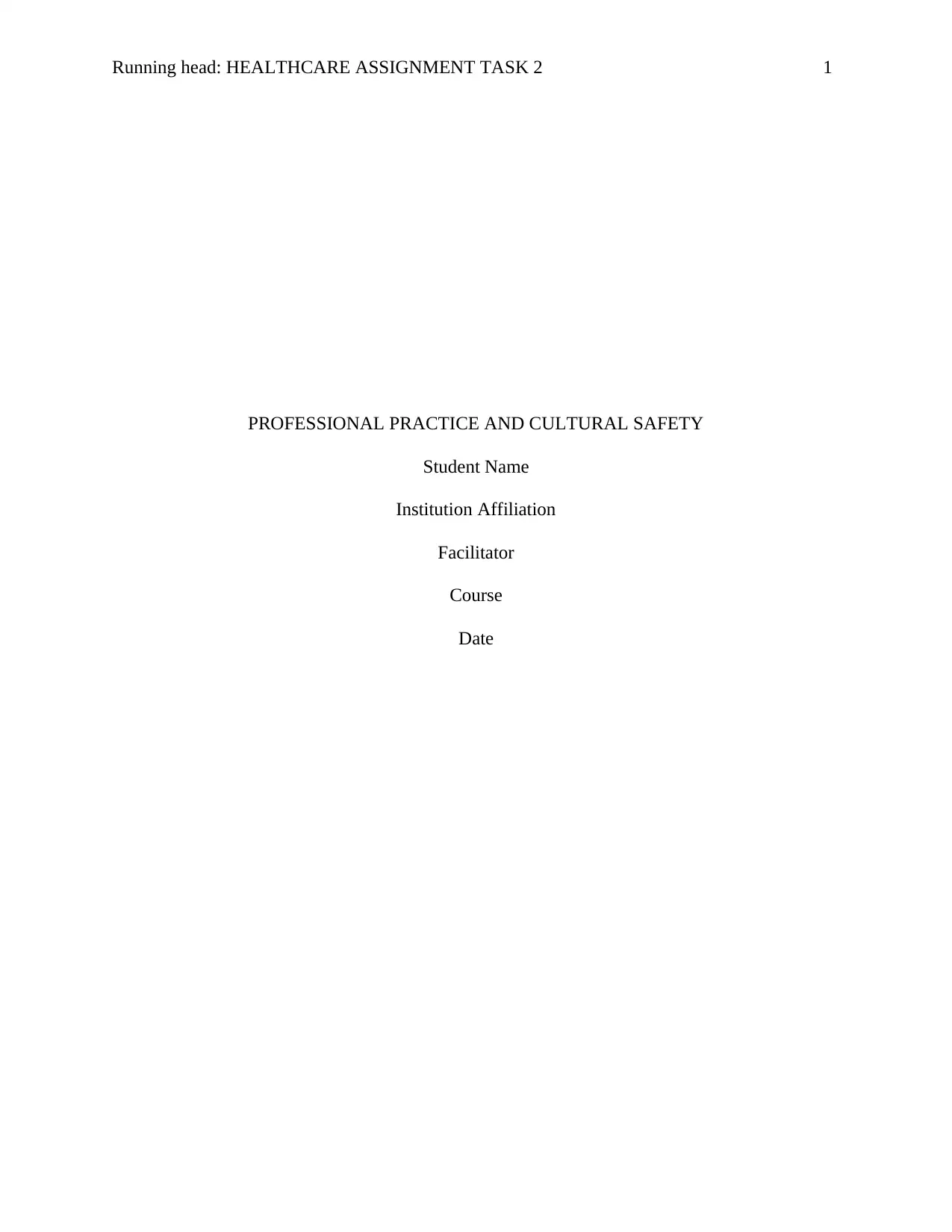
Running head: HEALTHCARE ASSIGNMENT TASK 2 1
PROFESSIONAL PRACTICE AND CULTURAL SAFETY
Student Name
Institution Affiliation
Facilitator
Course
Date
PROFESSIONAL PRACTICE AND CULTURAL SAFETY
Student Name
Institution Affiliation
Facilitator
Course
Date
Paraphrase This Document
Need a fresh take? Get an instant paraphrase of this document with our AI Paraphraser
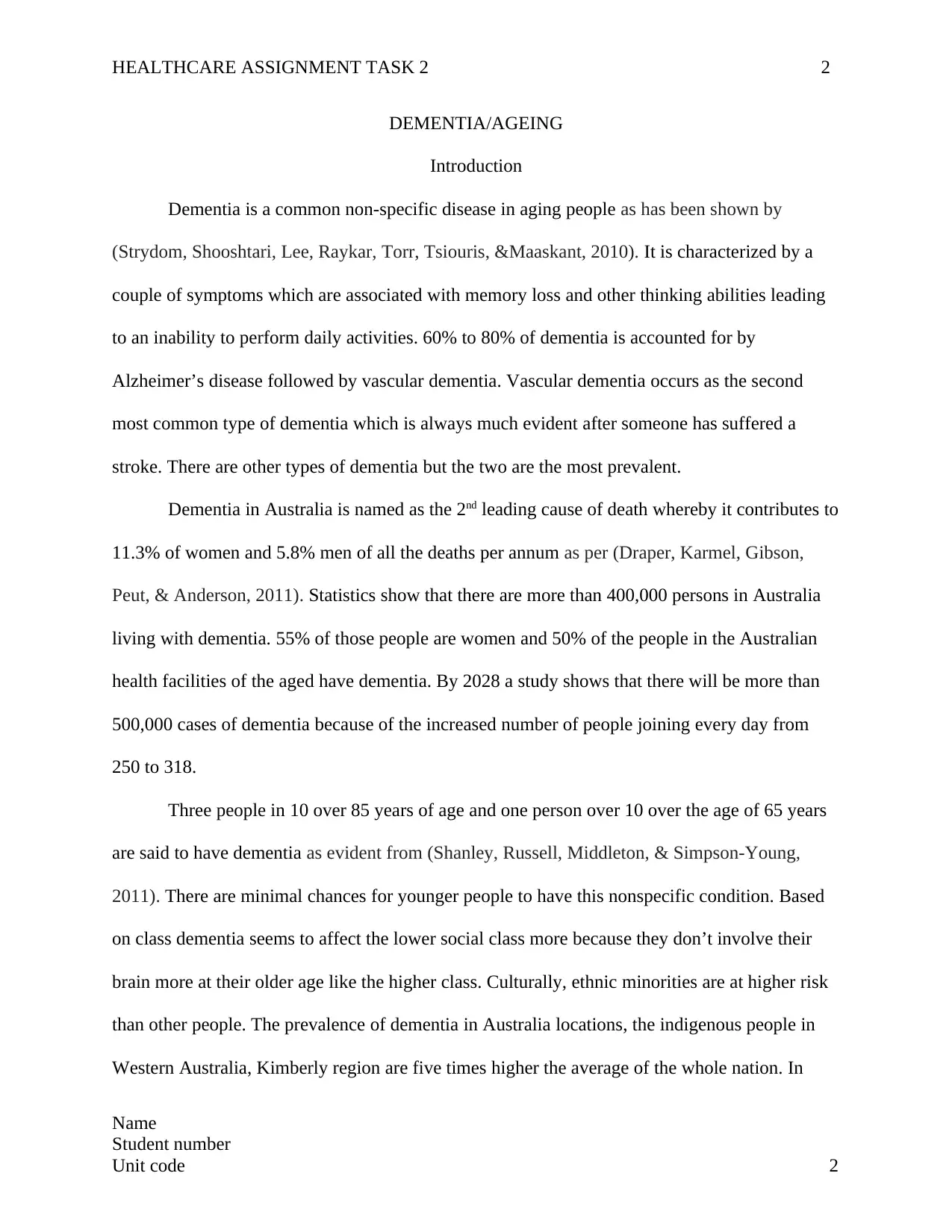
HEALTHCARE ASSIGNMENT TASK 2 2
DEMENTIA/AGEING
Introduction
Dementia is a common non-specific disease in aging people as has been shown by
(Strydom, Shooshtari, Lee, Raykar, Torr, Tsiouris, &Maaskant, 2010). It is characterized by a
couple of symptoms which are associated with memory loss and other thinking abilities leading
to an inability to perform daily activities. 60% to 80% of dementia is accounted for by
Alzheimer’s disease followed by vascular dementia. Vascular dementia occurs as the second
most common type of dementia which is always much evident after someone has suffered a
stroke. There are other types of dementia but the two are the most prevalent.
Dementia in Australia is named as the 2nd leading cause of death whereby it contributes to
11.3% of women and 5.8% men of all the deaths per annum as per (Draper, Karmel, Gibson,
Peut, & Anderson, 2011). Statistics show that there are more than 400,000 persons in Australia
living with dementia. 55% of those people are women and 50% of the people in the Australian
health facilities of the aged have dementia. By 2028 a study shows that there will be more than
500,000 cases of dementia because of the increased number of people joining every day from
250 to 318.
Three people in 10 over 85 years of age and one person over 10 over the age of 65 years
are said to have dementia as evident from (Shanley, Russell, Middleton, & Simpson-Young,
2011). There are minimal chances for younger people to have this nonspecific condition. Based
on class dementia seems to affect the lower social class more because they don’t involve their
brain more at their older age like the higher class. Culturally, ethnic minorities are at higher risk
than other people. The prevalence of dementia in Australia locations, the indigenous people in
Western Australia, Kimberly region are five times higher the average of the whole nation. In
Name
Student number
Unit code 2
DEMENTIA/AGEING
Introduction
Dementia is a common non-specific disease in aging people as has been shown by
(Strydom, Shooshtari, Lee, Raykar, Torr, Tsiouris, &Maaskant, 2010). It is characterized by a
couple of symptoms which are associated with memory loss and other thinking abilities leading
to an inability to perform daily activities. 60% to 80% of dementia is accounted for by
Alzheimer’s disease followed by vascular dementia. Vascular dementia occurs as the second
most common type of dementia which is always much evident after someone has suffered a
stroke. There are other types of dementia but the two are the most prevalent.
Dementia in Australia is named as the 2nd leading cause of death whereby it contributes to
11.3% of women and 5.8% men of all the deaths per annum as per (Draper, Karmel, Gibson,
Peut, & Anderson, 2011). Statistics show that there are more than 400,000 persons in Australia
living with dementia. 55% of those people are women and 50% of the people in the Australian
health facilities of the aged have dementia. By 2028 a study shows that there will be more than
500,000 cases of dementia because of the increased number of people joining every day from
250 to 318.
Three people in 10 over 85 years of age and one person over 10 over the age of 65 years
are said to have dementia as evident from (Shanley, Russell, Middleton, & Simpson-Young,
2011). There are minimal chances for younger people to have this nonspecific condition. Based
on class dementia seems to affect the lower social class more because they don’t involve their
brain more at their older age like the higher class. Culturally, ethnic minorities are at higher risk
than other people. The prevalence of dementia in Australia locations, the indigenous people in
Western Australia, Kimberly region are five times higher the average of the whole nation. In
Name
Student number
Unit code 2
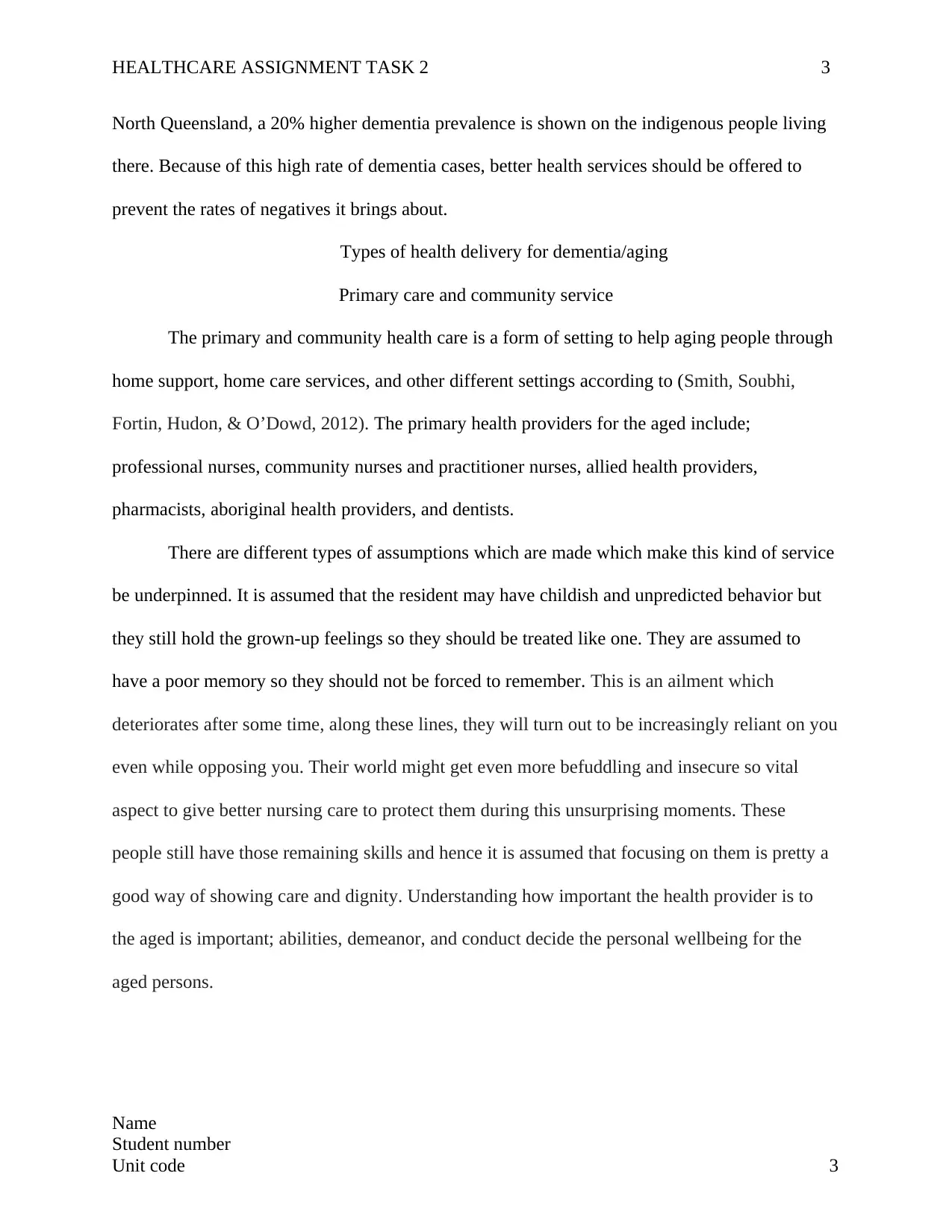
HEALTHCARE ASSIGNMENT TASK 2 3
North Queensland, a 20% higher dementia prevalence is shown on the indigenous people living
there. Because of this high rate of dementia cases, better health services should be offered to
prevent the rates of negatives it brings about.
Types of health delivery for dementia/aging
Primary care and community service
The primary and community health care is a form of setting to help aging people through
home support, home care services, and other different settings according to (Smith, Soubhi,
Fortin, Hudon, & O’Dowd, 2012). The primary health providers for the aged include;
professional nurses, community nurses and practitioner nurses, allied health providers,
pharmacists, aboriginal health providers, and dentists.
There are different types of assumptions which are made which make this kind of service
be underpinned. It is assumed that the resident may have childish and unpredicted behavior but
they still hold the grown-up feelings so they should be treated like one. They are assumed to
have a poor memory so they should not be forced to remember. This is an ailment which
deteriorates after some time, along these lines, they will turn out to be increasingly reliant on you
even while opposing you. Their world might get even more befuddling and insecure so vital
aspect to give better nursing care to protect them during this unsurprising moments. These
people still have those remaining skills and hence it is assumed that focusing on them is pretty a
good way of showing care and dignity. Understanding how important the health provider is to
the aged is important; abilities, demeanor, and conduct decide the personal wellbeing for the
aged persons.
Name
Student number
Unit code 3
North Queensland, a 20% higher dementia prevalence is shown on the indigenous people living
there. Because of this high rate of dementia cases, better health services should be offered to
prevent the rates of negatives it brings about.
Types of health delivery for dementia/aging
Primary care and community service
The primary and community health care is a form of setting to help aging people through
home support, home care services, and other different settings according to (Smith, Soubhi,
Fortin, Hudon, & O’Dowd, 2012). The primary health providers for the aged include;
professional nurses, community nurses and practitioner nurses, allied health providers,
pharmacists, aboriginal health providers, and dentists.
There are different types of assumptions which are made which make this kind of service
be underpinned. It is assumed that the resident may have childish and unpredicted behavior but
they still hold the grown-up feelings so they should be treated like one. They are assumed to
have a poor memory so they should not be forced to remember. This is an ailment which
deteriorates after some time, along these lines, they will turn out to be increasingly reliant on you
even while opposing you. Their world might get even more befuddling and insecure so vital
aspect to give better nursing care to protect them during this unsurprising moments. These
people still have those remaining skills and hence it is assumed that focusing on them is pretty a
good way of showing care and dignity. Understanding how important the health provider is to
the aged is important; abilities, demeanor, and conduct decide the personal wellbeing for the
aged persons.
Name
Student number
Unit code 3
⊘ This is a preview!⊘
Do you want full access?
Subscribe today to unlock all pages.

Trusted by 1+ million students worldwide
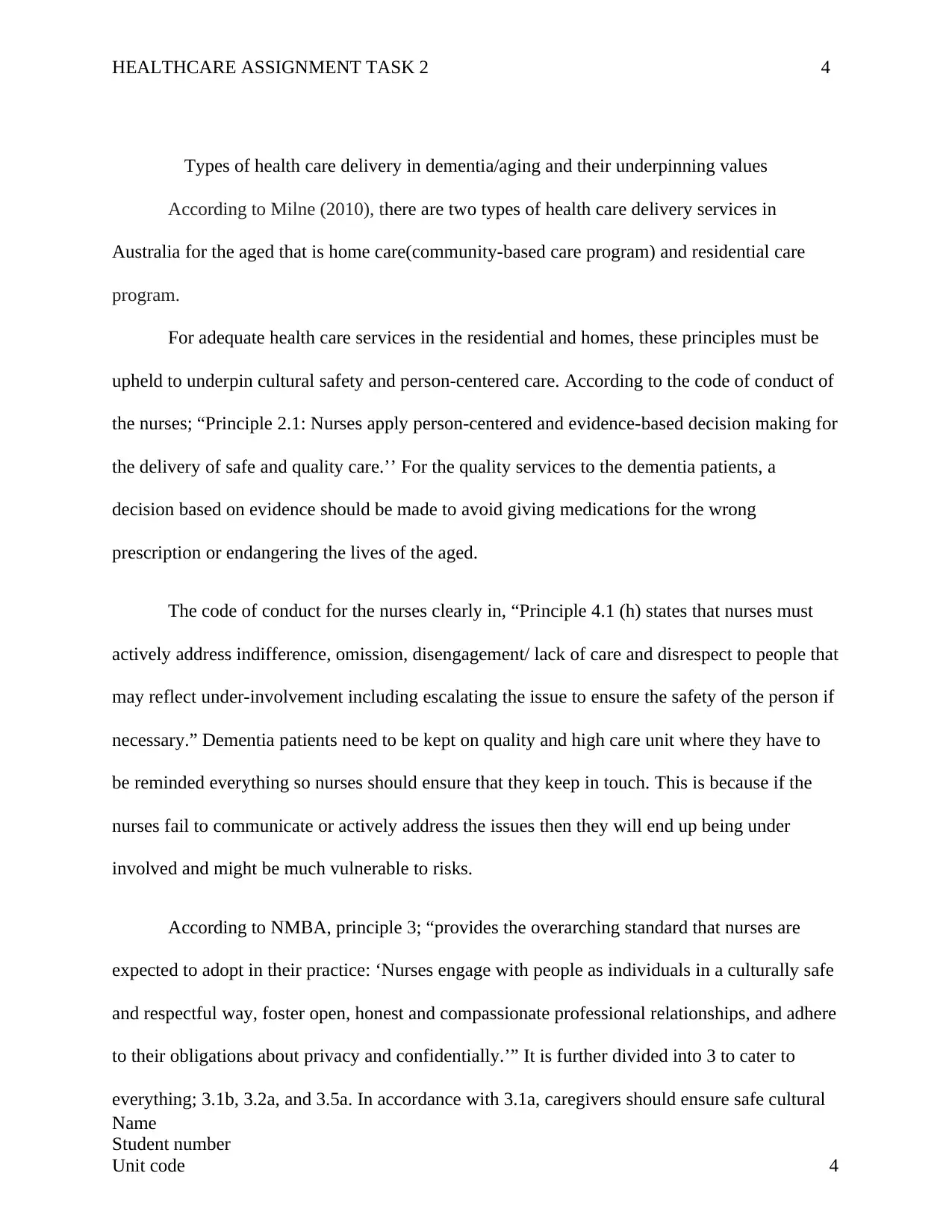
HEALTHCARE ASSIGNMENT TASK 2 4
Types of health care delivery in dementia/aging and their underpinning values
According to Milne (2010), there are two types of health care delivery services in
Australia for the aged that is home care(community-based care program) and residential care
program.
For adequate health care services in the residential and homes, these principles must be
upheld to underpin cultural safety and person-centered care. According to the code of conduct of
the nurses; “Principle 2.1: Nurses apply person-centered and evidence-based decision making for
the delivery of safe and quality care.’’ For the quality services to the dementia patients, a
decision based on evidence should be made to avoid giving medications for the wrong
prescription or endangering the lives of the aged.
The code of conduct for the nurses clearly in, “Principle 4.1 (h) states that nurses must
actively address indifference, omission, disengagement/ lack of care and disrespect to people that
may reflect under-involvement including escalating the issue to ensure the safety of the person if
necessary.” Dementia patients need to be kept on quality and high care unit where they have to
be reminded everything so nurses should ensure that they keep in touch. This is because if the
nurses fail to communicate or actively address the issues then they will end up being under
involved and might be much vulnerable to risks.
According to NMBA, principle 3; “provides the overarching standard that nurses are
expected to adopt in their practice: ‘Nurses engage with people as individuals in a culturally safe
and respectful way, foster open, honest and compassionate professional relationships, and adhere
to their obligations about privacy and confidentially.’” It is further divided into 3 to cater to
everything; 3.1b, 3.2a, and 3.5a. In accordance with 3.1a, caregivers should ensure safe cultural
Name
Student number
Unit code 4
Types of health care delivery in dementia/aging and their underpinning values
According to Milne (2010), there are two types of health care delivery services in
Australia for the aged that is home care(community-based care program) and residential care
program.
For adequate health care services in the residential and homes, these principles must be
upheld to underpin cultural safety and person-centered care. According to the code of conduct of
the nurses; “Principle 2.1: Nurses apply person-centered and evidence-based decision making for
the delivery of safe and quality care.’’ For the quality services to the dementia patients, a
decision based on evidence should be made to avoid giving medications for the wrong
prescription or endangering the lives of the aged.
The code of conduct for the nurses clearly in, “Principle 4.1 (h) states that nurses must
actively address indifference, omission, disengagement/ lack of care and disrespect to people that
may reflect under-involvement including escalating the issue to ensure the safety of the person if
necessary.” Dementia patients need to be kept on quality and high care unit where they have to
be reminded everything so nurses should ensure that they keep in touch. This is because if the
nurses fail to communicate or actively address the issues then they will end up being under
involved and might be much vulnerable to risks.
According to NMBA, principle 3; “provides the overarching standard that nurses are
expected to adopt in their practice: ‘Nurses engage with people as individuals in a culturally safe
and respectful way, foster open, honest and compassionate professional relationships, and adhere
to their obligations about privacy and confidentially.’” It is further divided into 3 to cater to
everything; 3.1b, 3.2a, and 3.5a. In accordance with 3.1a, caregivers should ensure safe cultural
Name
Student number
Unit code 4
Paraphrase This Document
Need a fresh take? Get an instant paraphrase of this document with our AI Paraphraser
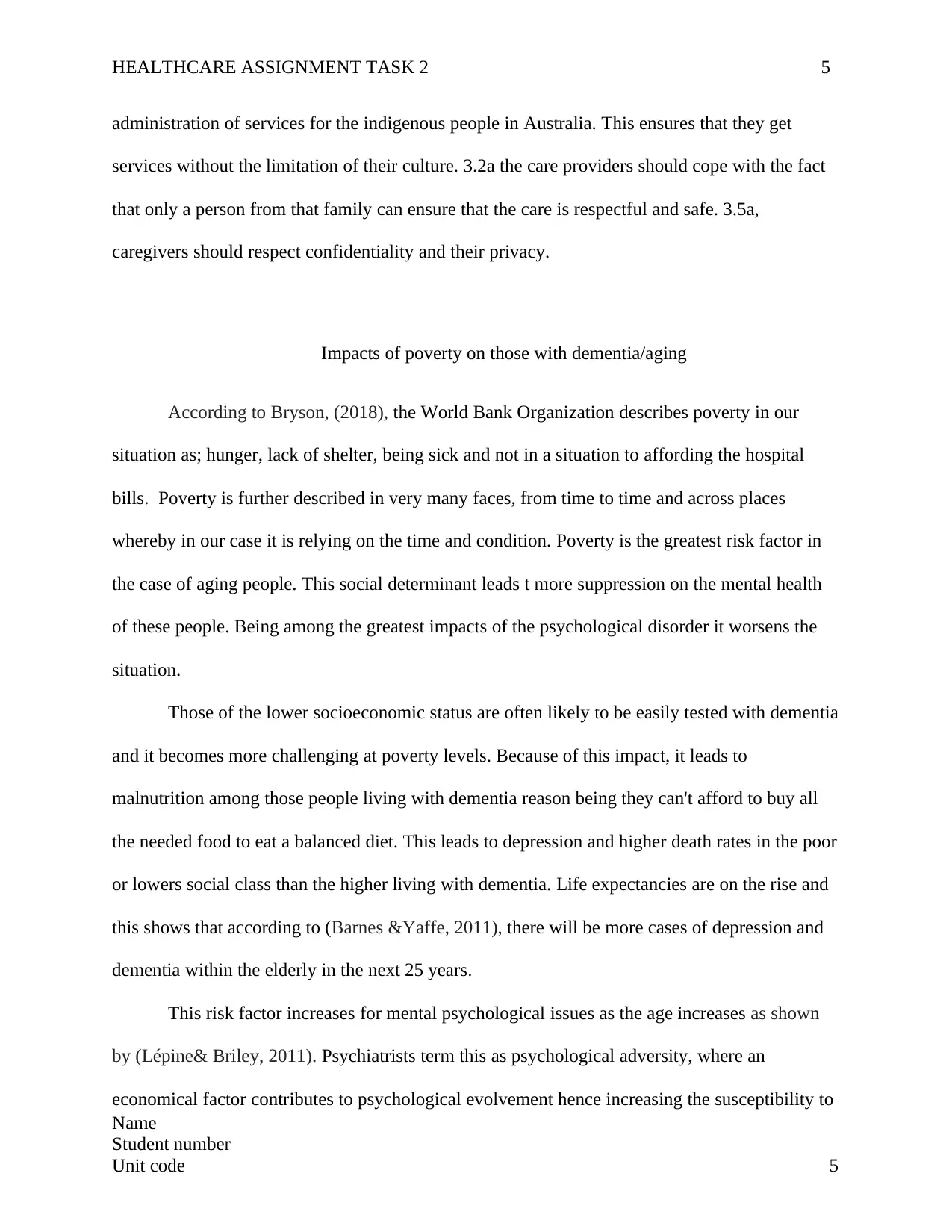
HEALTHCARE ASSIGNMENT TASK 2 5
administration of services for the indigenous people in Australia. This ensures that they get
services without the limitation of their culture. 3.2a the care providers should cope with the fact
that only a person from that family can ensure that the care is respectful and safe. 3.5a,
caregivers should respect confidentiality and their privacy.
Impacts of poverty on those with dementia/aging
According to Bryson, (2018), the World Bank Organization describes poverty in our
situation as; hunger, lack of shelter, being sick and not in a situation to affording the hospital
bills. Poverty is further described in very many faces, from time to time and across places
whereby in our case it is relying on the time and condition. Poverty is the greatest risk factor in
the case of aging people. This social determinant leads t more suppression on the mental health
of these people. Being among the greatest impacts of the psychological disorder it worsens the
situation.
Those of the lower socioeconomic status are often likely to be easily tested with dementia
and it becomes more challenging at poverty levels. Because of this impact, it leads to
malnutrition among those people living with dementia reason being they can't afford to buy all
the needed food to eat a balanced diet. This leads to depression and higher death rates in the poor
or lowers social class than the higher living with dementia. Life expectancies are on the rise and
this shows that according to (Barnes &Yaffe, 2011), there will be more cases of depression and
dementia within the elderly in the next 25 years.
This risk factor increases for mental psychological issues as the age increases as shown
by (Lépine& Briley, 2011). Psychiatrists term this as psychological adversity, where an
economical factor contributes to psychological evolvement hence increasing the susceptibility to
Name
Student number
Unit code 5
administration of services for the indigenous people in Australia. This ensures that they get
services without the limitation of their culture. 3.2a the care providers should cope with the fact
that only a person from that family can ensure that the care is respectful and safe. 3.5a,
caregivers should respect confidentiality and their privacy.
Impacts of poverty on those with dementia/aging
According to Bryson, (2018), the World Bank Organization describes poverty in our
situation as; hunger, lack of shelter, being sick and not in a situation to affording the hospital
bills. Poverty is further described in very many faces, from time to time and across places
whereby in our case it is relying on the time and condition. Poverty is the greatest risk factor in
the case of aging people. This social determinant leads t more suppression on the mental health
of these people. Being among the greatest impacts of the psychological disorder it worsens the
situation.
Those of the lower socioeconomic status are often likely to be easily tested with dementia
and it becomes more challenging at poverty levels. Because of this impact, it leads to
malnutrition among those people living with dementia reason being they can't afford to buy all
the needed food to eat a balanced diet. This leads to depression and higher death rates in the poor
or lowers social class than the higher living with dementia. Life expectancies are on the rise and
this shows that according to (Barnes &Yaffe, 2011), there will be more cases of depression and
dementia within the elderly in the next 25 years.
This risk factor increases for mental psychological issues as the age increases as shown
by (Lépine& Briley, 2011). Psychiatrists term this as psychological adversity, where an
economical factor contributes to psychological evolvement hence increasing the susceptibility to
Name
Student number
Unit code 5
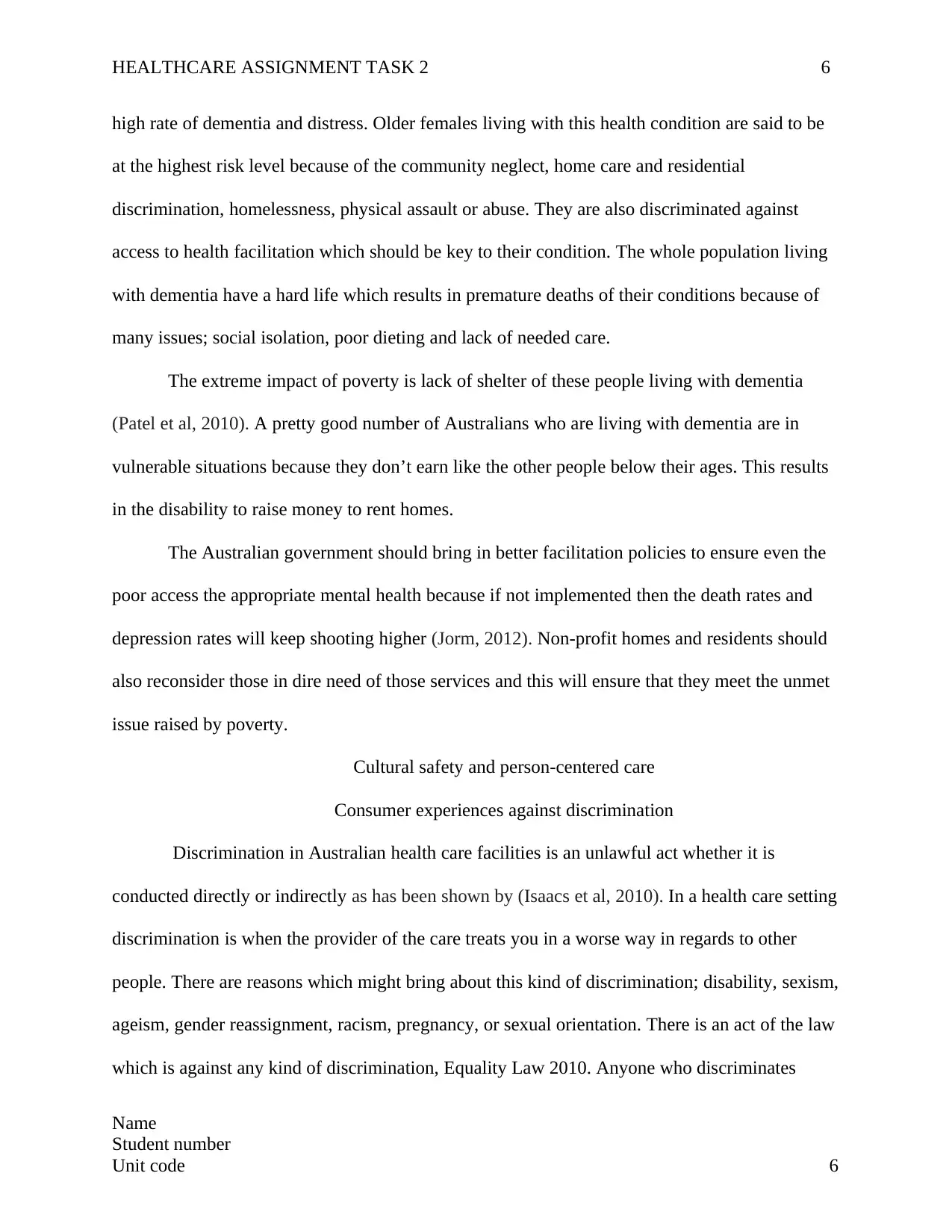
HEALTHCARE ASSIGNMENT TASK 2 6
high rate of dementia and distress. Older females living with this health condition are said to be
at the highest risk level because of the community neglect, home care and residential
discrimination, homelessness, physical assault or abuse. They are also discriminated against
access to health facilitation which should be key to their condition. The whole population living
with dementia have a hard life which results in premature deaths of their conditions because of
many issues; social isolation, poor dieting and lack of needed care.
The extreme impact of poverty is lack of shelter of these people living with dementia
(Patel et al, 2010). A pretty good number of Australians who are living with dementia are in
vulnerable situations because they don’t earn like the other people below their ages. This results
in the disability to raise money to rent homes.
The Australian government should bring in better facilitation policies to ensure even the
poor access the appropriate mental health because if not implemented then the death rates and
depression rates will keep shooting higher (Jorm, 2012). Non-profit homes and residents should
also reconsider those in dire need of those services and this will ensure that they meet the unmet
issue raised by poverty.
Cultural safety and person-centered care
Consumer experiences against discrimination
Discrimination in Australian health care facilities is an unlawful act whether it is
conducted directly or indirectly as has been shown by (Isaacs et al, 2010). In a health care setting
discrimination is when the provider of the care treats you in a worse way in regards to other
people. There are reasons which might bring about this kind of discrimination; disability, sexism,
ageism, gender reassignment, racism, pregnancy, or sexual orientation. There is an act of the law
which is against any kind of discrimination, Equality Law 2010. Anyone who discriminates
Name
Student number
Unit code 6
high rate of dementia and distress. Older females living with this health condition are said to be
at the highest risk level because of the community neglect, home care and residential
discrimination, homelessness, physical assault or abuse. They are also discriminated against
access to health facilitation which should be key to their condition. The whole population living
with dementia have a hard life which results in premature deaths of their conditions because of
many issues; social isolation, poor dieting and lack of needed care.
The extreme impact of poverty is lack of shelter of these people living with dementia
(Patel et al, 2010). A pretty good number of Australians who are living with dementia are in
vulnerable situations because they don’t earn like the other people below their ages. This results
in the disability to raise money to rent homes.
The Australian government should bring in better facilitation policies to ensure even the
poor access the appropriate mental health because if not implemented then the death rates and
depression rates will keep shooting higher (Jorm, 2012). Non-profit homes and residents should
also reconsider those in dire need of those services and this will ensure that they meet the unmet
issue raised by poverty.
Cultural safety and person-centered care
Consumer experiences against discrimination
Discrimination in Australian health care facilities is an unlawful act whether it is
conducted directly or indirectly as has been shown by (Isaacs et al, 2010). In a health care setting
discrimination is when the provider of the care treats you in a worse way in regards to other
people. There are reasons which might bring about this kind of discrimination; disability, sexism,
ageism, gender reassignment, racism, pregnancy, or sexual orientation. There is an act of the law
which is against any kind of discrimination, Equality Law 2010. Anyone who discriminates
Name
Student number
Unit code 6
⊘ This is a preview!⊘
Do you want full access?
Subscribe today to unlock all pages.

Trusted by 1+ million students worldwide
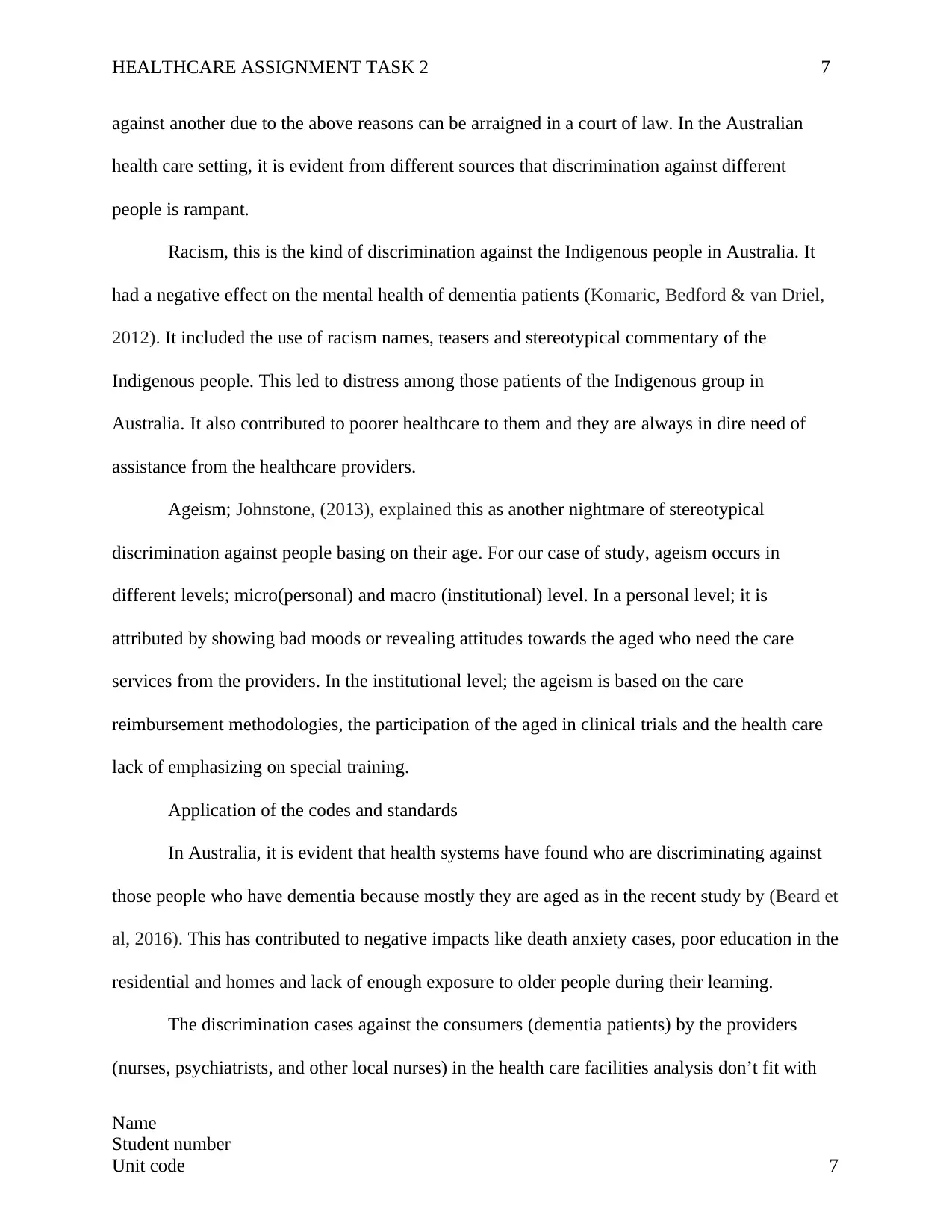
HEALTHCARE ASSIGNMENT TASK 2 7
against another due to the above reasons can be arraigned in a court of law. In the Australian
health care setting, it is evident from different sources that discrimination against different
people is rampant.
Racism, this is the kind of discrimination against the Indigenous people in Australia. It
had a negative effect on the mental health of dementia patients (Komaric, Bedford & van Driel,
2012). It included the use of racism names, teasers and stereotypical commentary of the
Indigenous people. This led to distress among those patients of the Indigenous group in
Australia. It also contributed to poorer healthcare to them and they are always in dire need of
assistance from the healthcare providers.
Ageism; Johnstone, (2013), explained this as another nightmare of stereotypical
discrimination against people basing on their age. For our case of study, ageism occurs in
different levels; micro(personal) and macro (institutional) level. In a personal level; it is
attributed by showing bad moods or revealing attitudes towards the aged who need the care
services from the providers. In the institutional level; the ageism is based on the care
reimbursement methodologies, the participation of the aged in clinical trials and the health care
lack of emphasizing on special training.
Application of the codes and standards
In Australia, it is evident that health systems have found who are discriminating against
those people who have dementia because mostly they are aged as in the recent study by (Beard et
al, 2016). This has contributed to negative impacts like death anxiety cases, poor education in the
residential and homes and lack of enough exposure to older people during their learning.
The discrimination cases against the consumers (dementia patients) by the providers
(nurses, psychiatrists, and other local nurses) in the health care facilities analysis don’t fit with
Name
Student number
Unit code 7
against another due to the above reasons can be arraigned in a court of law. In the Australian
health care setting, it is evident from different sources that discrimination against different
people is rampant.
Racism, this is the kind of discrimination against the Indigenous people in Australia. It
had a negative effect on the mental health of dementia patients (Komaric, Bedford & van Driel,
2012). It included the use of racism names, teasers and stereotypical commentary of the
Indigenous people. This led to distress among those patients of the Indigenous group in
Australia. It also contributed to poorer healthcare to them and they are always in dire need of
assistance from the healthcare providers.
Ageism; Johnstone, (2013), explained this as another nightmare of stereotypical
discrimination against people basing on their age. For our case of study, ageism occurs in
different levels; micro(personal) and macro (institutional) level. In a personal level; it is
attributed by showing bad moods or revealing attitudes towards the aged who need the care
services from the providers. In the institutional level; the ageism is based on the care
reimbursement methodologies, the participation of the aged in clinical trials and the health care
lack of emphasizing on special training.
Application of the codes and standards
In Australia, it is evident that health systems have found who are discriminating against
those people who have dementia because mostly they are aged as in the recent study by (Beard et
al, 2016). This has contributed to negative impacts like death anxiety cases, poor education in the
residential and homes and lack of enough exposure to older people during their learning.
The discrimination cases against the consumers (dementia patients) by the providers
(nurses, psychiatrists, and other local nurses) in the health care facilities analysis don’t fit with
Name
Student number
Unit code 7
Paraphrase This Document
Need a fresh take? Get an instant paraphrase of this document with our AI Paraphraser
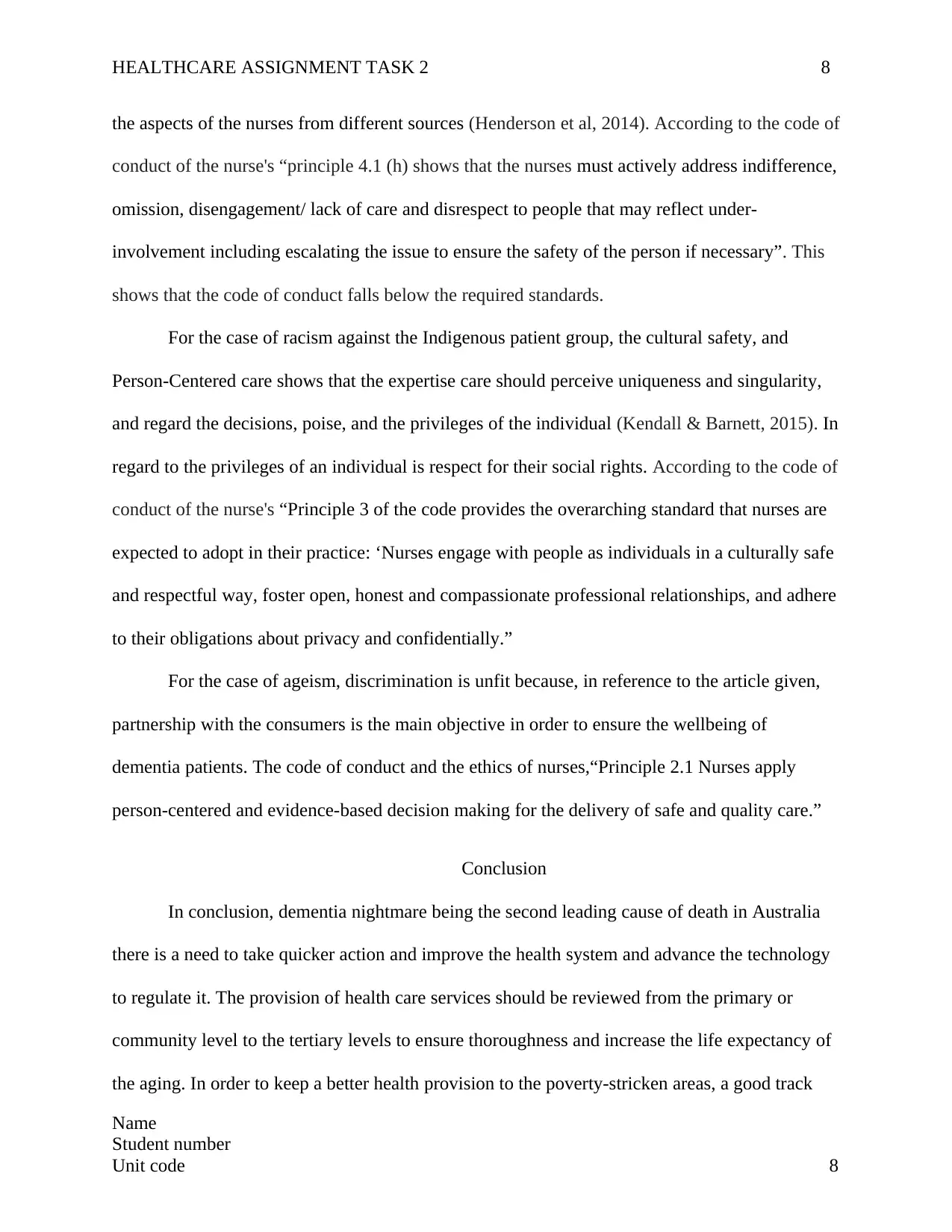
HEALTHCARE ASSIGNMENT TASK 2 8
the aspects of the nurses from different sources (Henderson et al, 2014). According to the code of
conduct of the nurse's “principle 4.1 (h) shows that the nurses must actively address indifference,
omission, disengagement/ lack of care and disrespect to people that may reflect under-
involvement including escalating the issue to ensure the safety of the person if necessary”. This
shows that the code of conduct falls below the required standards.
For the case of racism against the Indigenous patient group, the cultural safety, and
Person-Centered care shows that the expertise care should perceive uniqueness and singularity,
and regard the decisions, poise, and the privileges of the individual (Kendall & Barnett, 2015). In
regard to the privileges of an individual is respect for their social rights. According to the code of
conduct of the nurse's “Principle 3 of the code provides the overarching standard that nurses are
expected to adopt in their practice: ‘Nurses engage with people as individuals in a culturally safe
and respectful way, foster open, honest and compassionate professional relationships, and adhere
to their obligations about privacy and confidentially.”
For the case of ageism, discrimination is unfit because, in reference to the article given,
partnership with the consumers is the main objective in order to ensure the wellbeing of
dementia patients. The code of conduct and the ethics of nurses,“Principle 2.1 Nurses apply
person-centered and evidence-based decision making for the delivery of safe and quality care.”
Conclusion
In conclusion, dementia nightmare being the second leading cause of death in Australia
there is a need to take quicker action and improve the health system and advance the technology
to regulate it. The provision of health care services should be reviewed from the primary or
community level to the tertiary levels to ensure thoroughness and increase the life expectancy of
the aging. In order to keep a better health provision to the poverty-stricken areas, a good track
Name
Student number
Unit code 8
the aspects of the nurses from different sources (Henderson et al, 2014). According to the code of
conduct of the nurse's “principle 4.1 (h) shows that the nurses must actively address indifference,
omission, disengagement/ lack of care and disrespect to people that may reflect under-
involvement including escalating the issue to ensure the safety of the person if necessary”. This
shows that the code of conduct falls below the required standards.
For the case of racism against the Indigenous patient group, the cultural safety, and
Person-Centered care shows that the expertise care should perceive uniqueness and singularity,
and regard the decisions, poise, and the privileges of the individual (Kendall & Barnett, 2015). In
regard to the privileges of an individual is respect for their social rights. According to the code of
conduct of the nurse's “Principle 3 of the code provides the overarching standard that nurses are
expected to adopt in their practice: ‘Nurses engage with people as individuals in a culturally safe
and respectful way, foster open, honest and compassionate professional relationships, and adhere
to their obligations about privacy and confidentially.”
For the case of ageism, discrimination is unfit because, in reference to the article given,
partnership with the consumers is the main objective in order to ensure the wellbeing of
dementia patients. The code of conduct and the ethics of nurses,“Principle 2.1 Nurses apply
person-centered and evidence-based decision making for the delivery of safe and quality care.”
Conclusion
In conclusion, dementia nightmare being the second leading cause of death in Australia
there is a need to take quicker action and improve the health system and advance the technology
to regulate it. The provision of health care services should be reviewed from the primary or
community level to the tertiary levels to ensure thoroughness and increase the life expectancy of
the aging. In order to keep a better health provision to the poverty-stricken areas, a good track
Name
Student number
Unit code 8
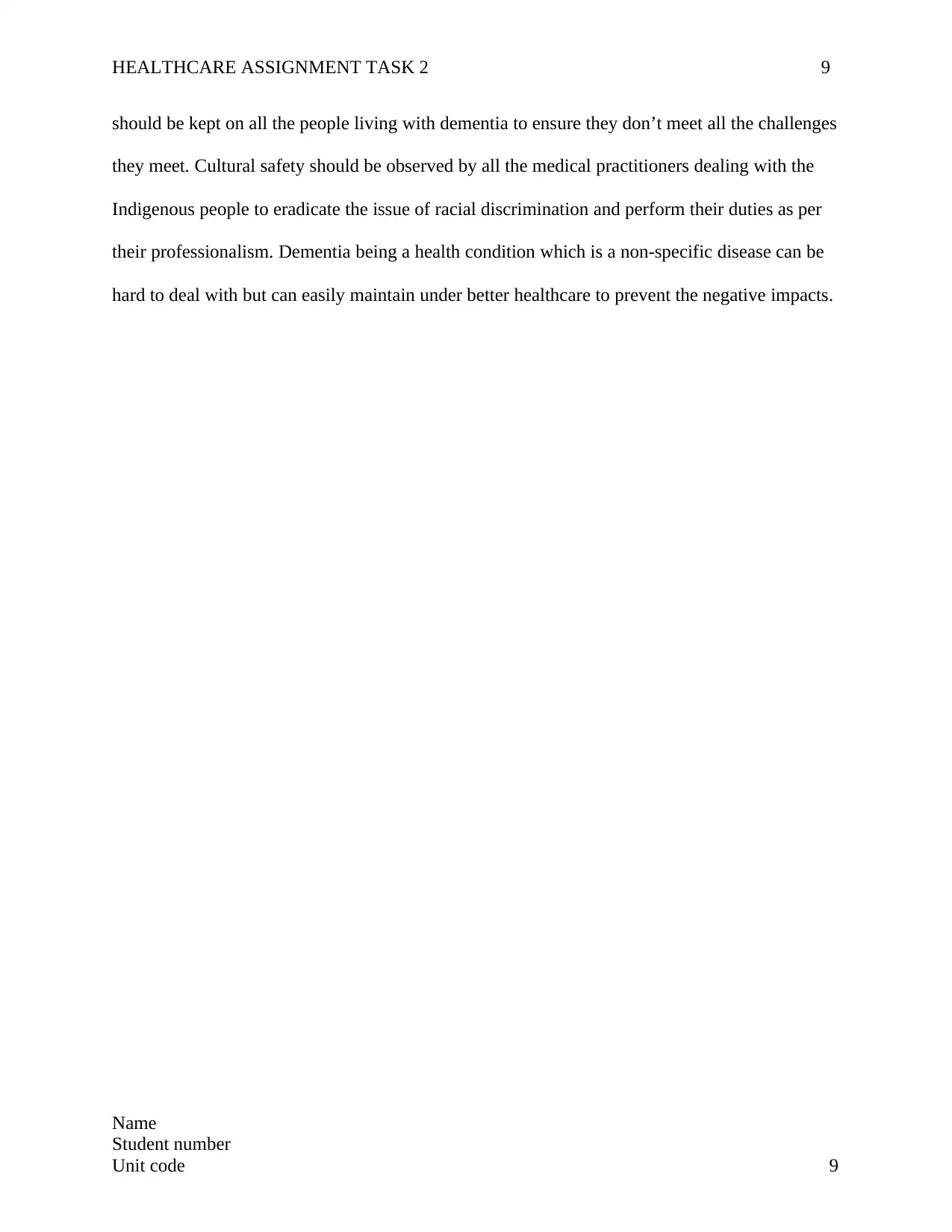
HEALTHCARE ASSIGNMENT TASK 2 9
should be kept on all the people living with dementia to ensure they don’t meet all the challenges
they meet. Cultural safety should be observed by all the medical practitioners dealing with the
Indigenous people to eradicate the issue of racial discrimination and perform their duties as per
their professionalism. Dementia being a health condition which is a non-specific disease can be
hard to deal with but can easily maintain under better healthcare to prevent the negative impacts.
Name
Student number
Unit code 9
should be kept on all the people living with dementia to ensure they don’t meet all the challenges
they meet. Cultural safety should be observed by all the medical practitioners dealing with the
Indigenous people to eradicate the issue of racial discrimination and perform their duties as per
their professionalism. Dementia being a health condition which is a non-specific disease can be
hard to deal with but can easily maintain under better healthcare to prevent the negative impacts.
Name
Student number
Unit code 9
⊘ This is a preview!⊘
Do you want full access?
Subscribe today to unlock all pages.

Trusted by 1+ million students worldwide
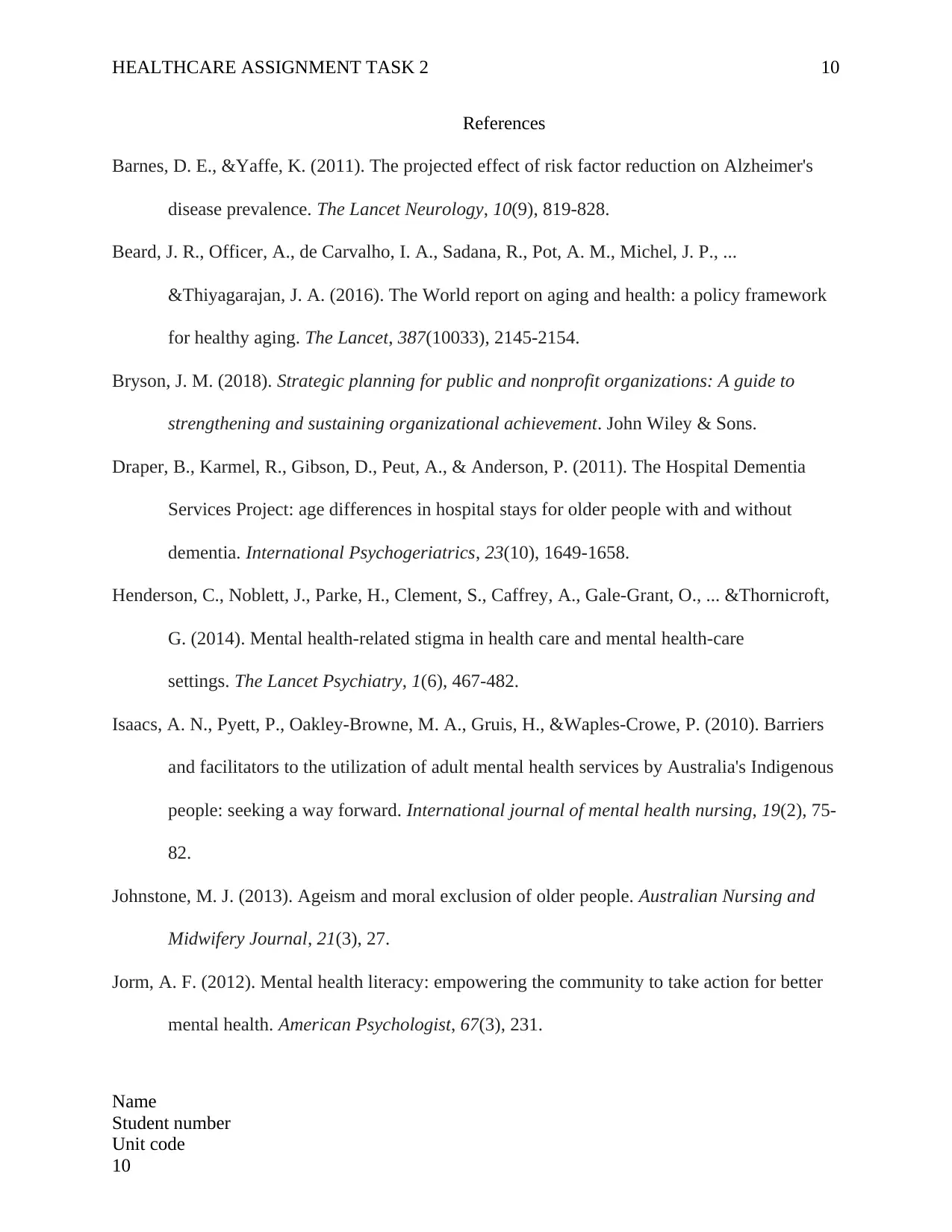
HEALTHCARE ASSIGNMENT TASK 2 10
References
Barnes, D. E., &Yaffe, K. (2011). The projected effect of risk factor reduction on Alzheimer's
disease prevalence. The Lancet Neurology, 10(9), 819-828.
Beard, J. R., Officer, A., de Carvalho, I. A., Sadana, R., Pot, A. M., Michel, J. P., ...
&Thiyagarajan, J. A. (2016). The World report on aging and health: a policy framework
for healthy aging. The Lancet, 387(10033), 2145-2154.
Bryson, J. M. (2018). Strategic planning for public and nonprofit organizations: A guide to
strengthening and sustaining organizational achievement. John Wiley & Sons.
Draper, B., Karmel, R., Gibson, D., Peut, A., & Anderson, P. (2011). The Hospital Dementia
Services Project: age differences in hospital stays for older people with and without
dementia. International Psychogeriatrics, 23(10), 1649-1658.
Henderson, C., Noblett, J., Parke, H., Clement, S., Caffrey, A., Gale-Grant, O., ... &Thornicroft,
G. (2014). Mental health-related stigma in health care and mental health-care
settings. The Lancet Psychiatry, 1(6), 467-482.
Isaacs, A. N., Pyett, P., Oakley‐Browne, M. A., Gruis, H., &Waples‐Crowe, P. (2010). Barriers
and facilitators to the utilization of adult mental health services by Australia's Indigenous
people: seeking a way forward. International journal of mental health nursing, 19(2), 75-
82.
Johnstone, M. J. (2013). Ageism and moral exclusion of older people. Australian Nursing and
Midwifery Journal, 21(3), 27.
Jorm, A. F. (2012). Mental health literacy: empowering the community to take action for better
mental health. American Psychologist, 67(3), 231.
Name
Student number
Unit code
10
References
Barnes, D. E., &Yaffe, K. (2011). The projected effect of risk factor reduction on Alzheimer's
disease prevalence. The Lancet Neurology, 10(9), 819-828.
Beard, J. R., Officer, A., de Carvalho, I. A., Sadana, R., Pot, A. M., Michel, J. P., ...
&Thiyagarajan, J. A. (2016). The World report on aging and health: a policy framework
for healthy aging. The Lancet, 387(10033), 2145-2154.
Bryson, J. M. (2018). Strategic planning for public and nonprofit organizations: A guide to
strengthening and sustaining organizational achievement. John Wiley & Sons.
Draper, B., Karmel, R., Gibson, D., Peut, A., & Anderson, P. (2011). The Hospital Dementia
Services Project: age differences in hospital stays for older people with and without
dementia. International Psychogeriatrics, 23(10), 1649-1658.
Henderson, C., Noblett, J., Parke, H., Clement, S., Caffrey, A., Gale-Grant, O., ... &Thornicroft,
G. (2014). Mental health-related stigma in health care and mental health-care
settings. The Lancet Psychiatry, 1(6), 467-482.
Isaacs, A. N., Pyett, P., Oakley‐Browne, M. A., Gruis, H., &Waples‐Crowe, P. (2010). Barriers
and facilitators to the utilization of adult mental health services by Australia's Indigenous
people: seeking a way forward. International journal of mental health nursing, 19(2), 75-
82.
Johnstone, M. J. (2013). Ageism and moral exclusion of older people. Australian Nursing and
Midwifery Journal, 21(3), 27.
Jorm, A. F. (2012). Mental health literacy: empowering the community to take action for better
mental health. American Psychologist, 67(3), 231.
Name
Student number
Unit code
10
Paraphrase This Document
Need a fresh take? Get an instant paraphrase of this document with our AI Paraphraser

HEALTHCARE ASSIGNMENT TASK 2 11
Kendall, E., & Barnett, L. (2015). Principles for the development of Aboriginal health
interventions: culturally appropriate methods through systemic empathy. Ethnicity &
health, 20(5), 437-452.
Komaric, N., Bedford, S., & van Driel, M. L. (2012). Two sides of the coin: patient and provider
perceptions of health care delivery to patients from culturally and linguistically diverse
backgrounds. BMC health services research, 12(1), 322.
Lépine, J. P., & Briley, M. (2011). The increasing burden of depression. Neuropsychiatric
disease and treatment, 7(Suppl 1), 3.
Milne, A. (2010). Dementia screening and early diagnosis: The case for and against. Health, risk
& society, 12(1), 65-76.
Patel, V., Lund, C., Hatherill, S., Plagerson, S., Corrigall, J., Funk, M., &Flisher, A. J. (2010).
Mental disorders: equity and social determinants. Equity, social determinants, and public
health programmes, 115, 134.
Shanley, C., Russell, C., Middleton, H., & Simpson-Young, V. (2011). Living through end-stage
dementia: The experiences and expressed needs of family carers. Dementia, 10(3), 325-
340.
Smith, S. M., Soubhi, H., Fortin, M., Hudon, C., & O’Dowd, T. (2012). Managing patients with
multimorbidity: a systematic review of interventions in primary care and community
settings. BMJ, 345, e5205.
Strydom, A., Shooshtari, S., Lee, L., Raykar, V., Torr, J., Tsiouris, J., ... &Maaskant, M. (2010).
Dementia in older adults with intellectual disabilities—epidemiology, presentation, and
diagnosis. Journal of Policy and Practice in Intellectual Disabilities, 7(2), 96-110.
Name
Student number
Unit code
11
Kendall, E., & Barnett, L. (2015). Principles for the development of Aboriginal health
interventions: culturally appropriate methods through systemic empathy. Ethnicity &
health, 20(5), 437-452.
Komaric, N., Bedford, S., & van Driel, M. L. (2012). Two sides of the coin: patient and provider
perceptions of health care delivery to patients from culturally and linguistically diverse
backgrounds. BMC health services research, 12(1), 322.
Lépine, J. P., & Briley, M. (2011). The increasing burden of depression. Neuropsychiatric
disease and treatment, 7(Suppl 1), 3.
Milne, A. (2010). Dementia screening and early diagnosis: The case for and against. Health, risk
& society, 12(1), 65-76.
Patel, V., Lund, C., Hatherill, S., Plagerson, S., Corrigall, J., Funk, M., &Flisher, A. J. (2010).
Mental disorders: equity and social determinants. Equity, social determinants, and public
health programmes, 115, 134.
Shanley, C., Russell, C., Middleton, H., & Simpson-Young, V. (2011). Living through end-stage
dementia: The experiences and expressed needs of family carers. Dementia, 10(3), 325-
340.
Smith, S. M., Soubhi, H., Fortin, M., Hudon, C., & O’Dowd, T. (2012). Managing patients with
multimorbidity: a systematic review of interventions in primary care and community
settings. BMJ, 345, e5205.
Strydom, A., Shooshtari, S., Lee, L., Raykar, V., Torr, J., Tsiouris, J., ... &Maaskant, M. (2010).
Dementia in older adults with intellectual disabilities—epidemiology, presentation, and
diagnosis. Journal of Policy and Practice in Intellectual Disabilities, 7(2), 96-110.
Name
Student number
Unit code
11
1 out of 11
Related Documents
Your All-in-One AI-Powered Toolkit for Academic Success.
+13062052269
info@desklib.com
Available 24*7 on WhatsApp / Email
![[object Object]](/_next/static/media/star-bottom.7253800d.svg)
Unlock your academic potential
© 2024 | Zucol Services PVT LTD | All rights reserved.





